Marketing Lecture 4 “Marketing environment” Lecturer: DBA,
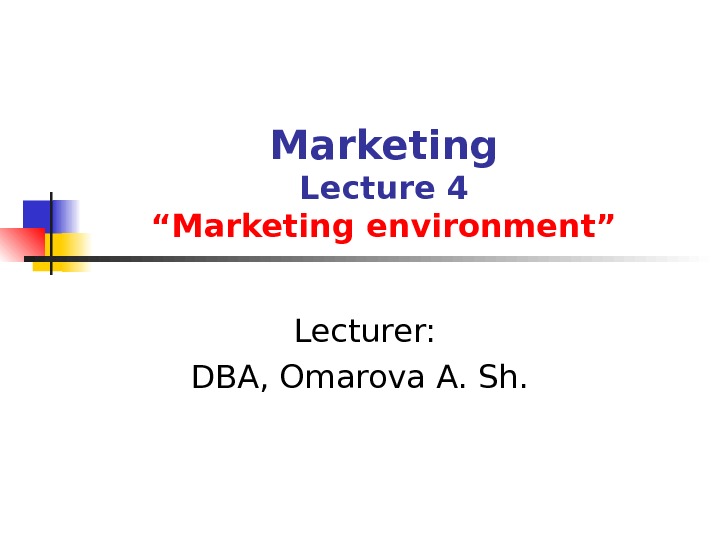
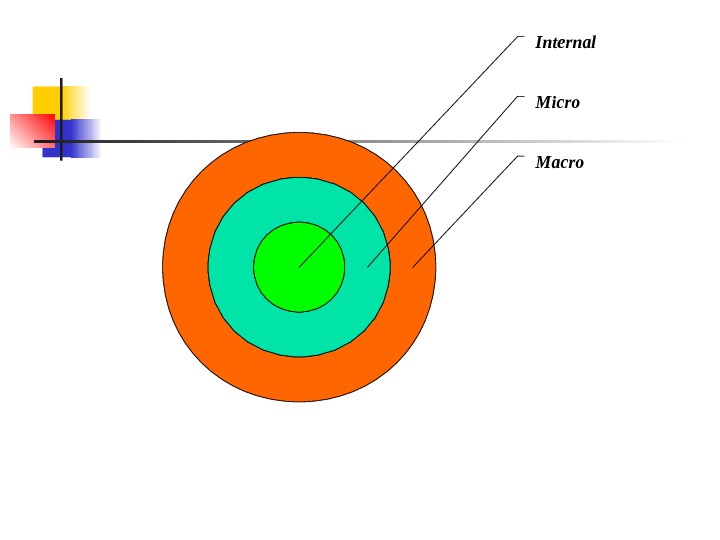
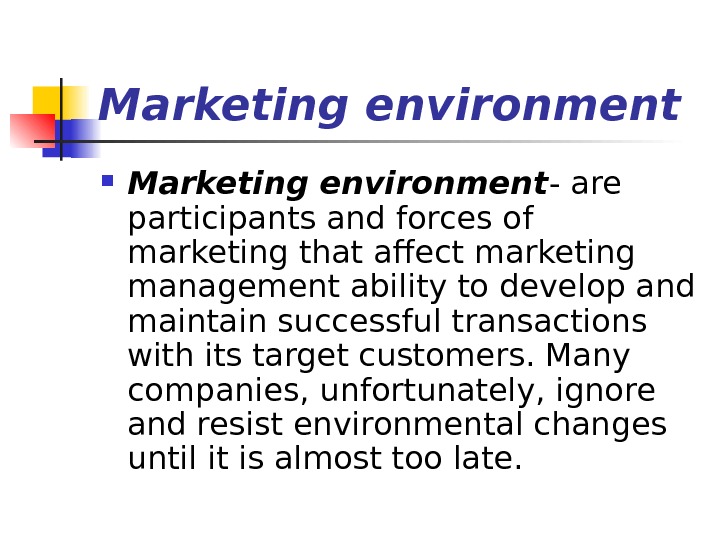

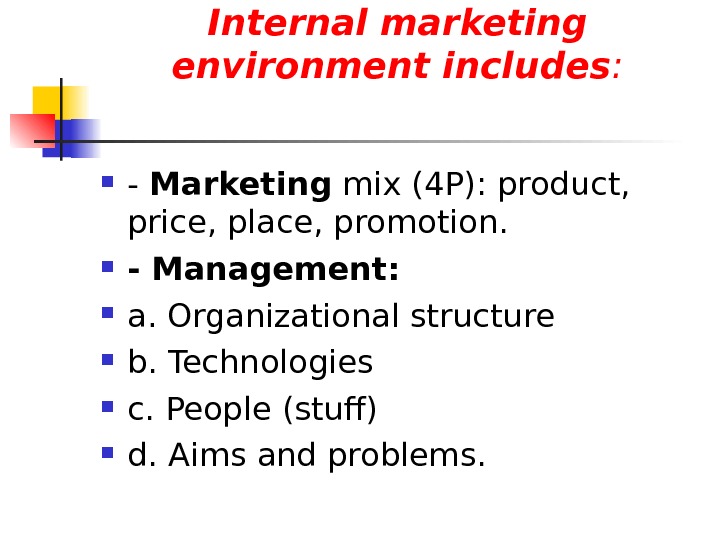
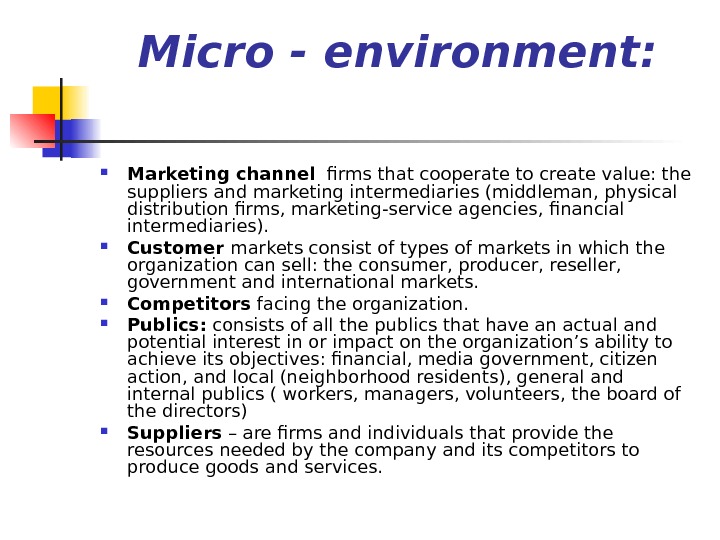
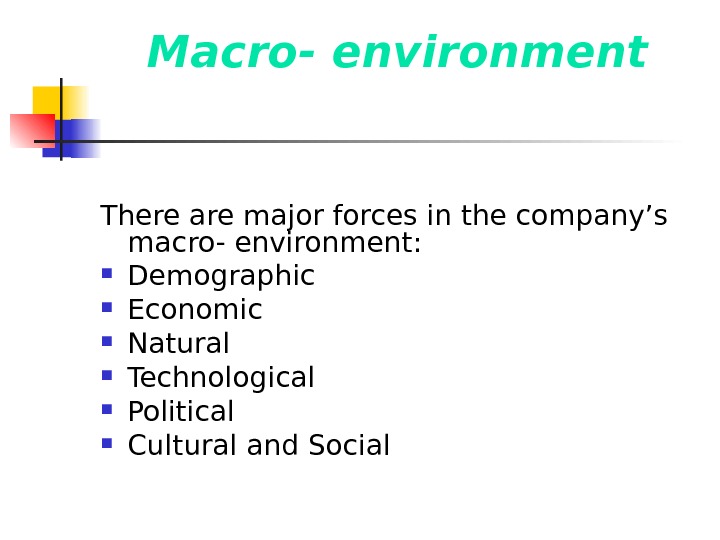
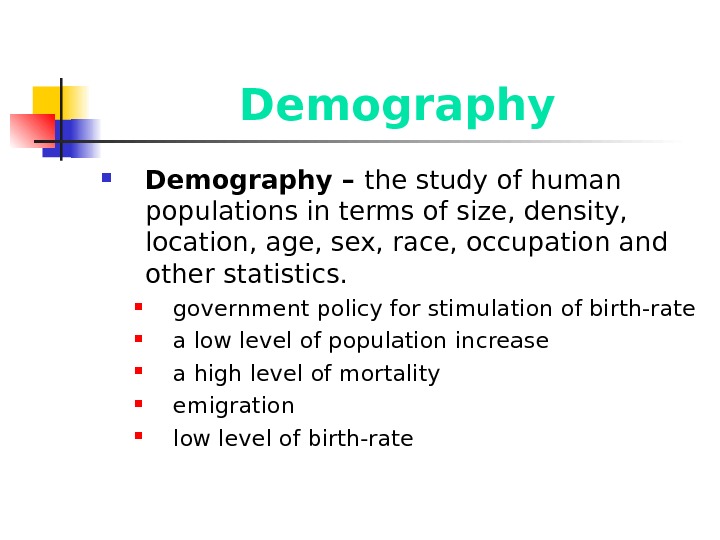
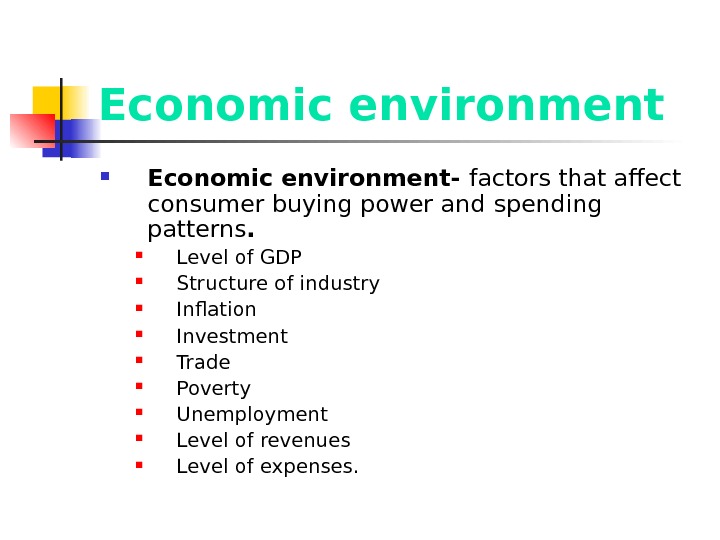
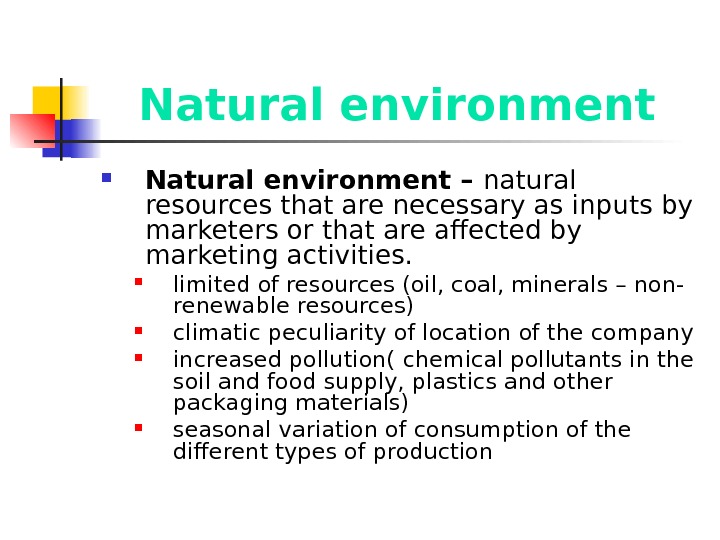
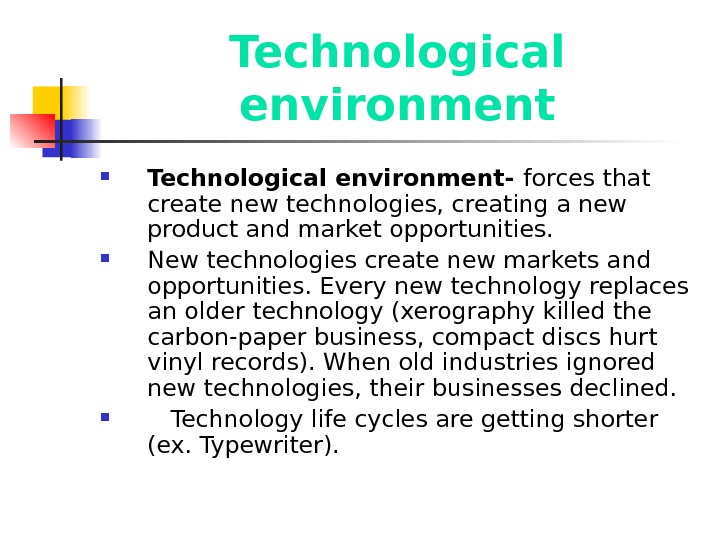
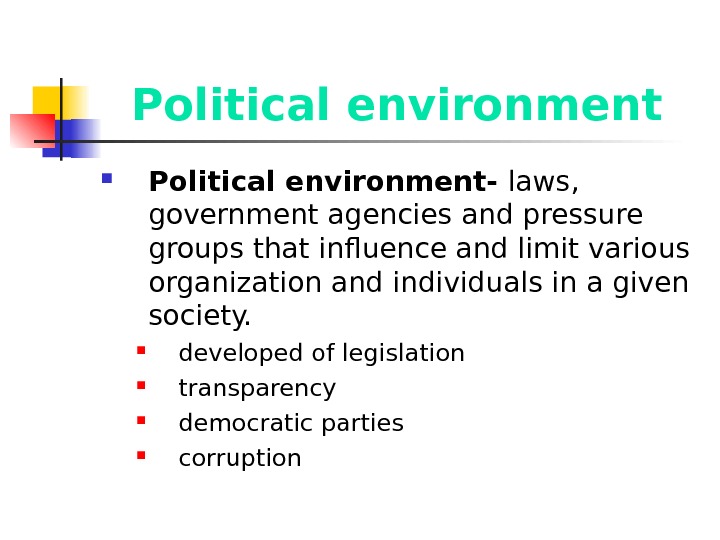

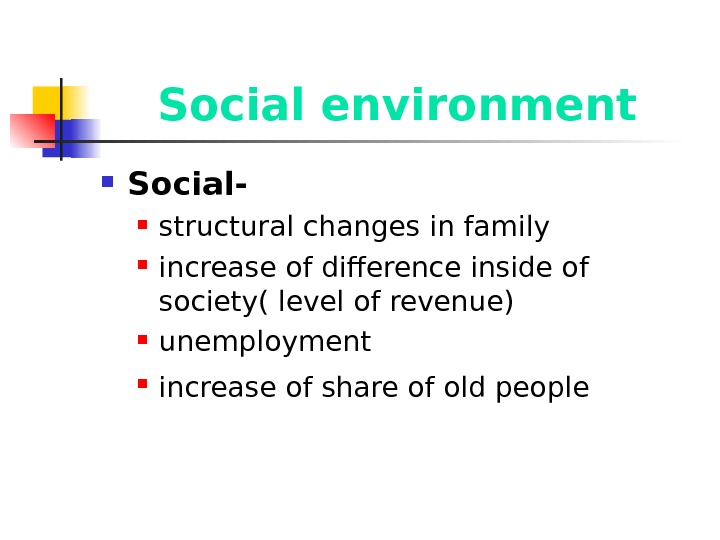


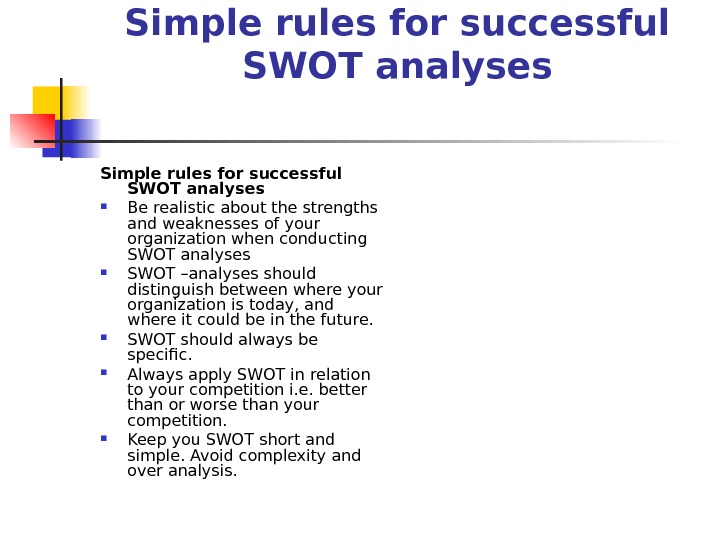
marketing._lecture_n4.ppt
- Размер: 276.5 Кб
- Количество слайдов: 17
Описание презентации Marketing Lecture 4 “Marketing environment” Lecturer: DBA, по слайдам
 Marketing Lecture 4 “Marketing environment” Lecturer: DBA, Omarova A. Sh.
Marketing Lecture 4 “Marketing environment” Lecturer: DBA, Omarova A. Sh.
 Macro Micro. Internal
Macro Micro. Internal
 Marketing environment — are participants and forces of marketing that affect marketing management ability to develop and maintain successful transactions with its target customers. Many companies, unfortunately, ignore and resist environmental changes until it is almost too late.
Marketing environment — are participants and forces of marketing that affect marketing management ability to develop and maintain successful transactions with its target customers. Many companies, unfortunately, ignore and resist environmental changes until it is almost too late.
 The marketing environment is made of : The internal environment Micro-environment Macro-environment
The marketing environment is made of : The internal environment Micro-environment Macro-environment
 Internal marketing environment includes : — Marketing mix (4 P): product, price, place, promotion. — Management: a. Organizational structure b. Technologies c. People (stuff) d. Aims and problems.
Internal marketing environment includes : — Marketing mix (4 P): product, price, place, promotion. — Management: a. Organizational structure b. Technologies c. People (stuff) d. Aims and problems.
 Micro — environment : Marketing channel firms that cooperate to create value: the suppliers and marketing intermediaries (middleman, physical distribution firms, marketing-service agencies, financial intermediaries). Customer markets consist of types of markets in which the organization can sell: the consumer, producer, reseller, government and international markets. Competitors facing the organization. Publics: consists of all the publics that have an actual and potential interest in or impact on the organization’s ability to achieve its objectives: financial, media government, citizen action, and local (neighborhood residents), general and internal publics ( workers, managers, volunteers, the board of the directors) Suppliers – are firms and individuals that provide the resources needed by the company and its competitors to produce goods and services.
Micro — environment : Marketing channel firms that cooperate to create value: the suppliers and marketing intermediaries (middleman, physical distribution firms, marketing-service agencies, financial intermediaries). Customer markets consist of types of markets in which the organization can sell: the consumer, producer, reseller, government and international markets. Competitors facing the organization. Publics: consists of all the publics that have an actual and potential interest in or impact on the organization’s ability to achieve its objectives: financial, media government, citizen action, and local (neighborhood residents), general and internal publics ( workers, managers, volunteers, the board of the directors) Suppliers – are firms and individuals that provide the resources needed by the company and its competitors to produce goods and services.
 Macro- environment There are major forces in the company’s macro- environment: Demographic Economic Natural Technological Political Cultural and Social
Macro- environment There are major forces in the company’s macro- environment: Demographic Economic Natural Technological Political Cultural and Social
 Demography – the study of human populations in terms of size, density, location, age, sex, race, occupation and other statistics. government policy for stimulation of birth-rate a low level of population increase a high level of mortality emigration low level of birth-rate
Demography – the study of human populations in terms of size, density, location, age, sex, race, occupation and other statistics. government policy for stimulation of birth-rate a low level of population increase a high level of mortality emigration low level of birth-rate
 Economic environment- factors that affect consumer buying power and spending patterns. Level of GDP Structure of industry Inflation Investment Trade Poverty Unemployment Level of revenues Level of expenses.
Economic environment- factors that affect consumer buying power and spending patterns. Level of GDP Structure of industry Inflation Investment Trade Poverty Unemployment Level of revenues Level of expenses.
 Natural environment – natural resources that are necessary as inputs by marketers or that are affected by marketing activities. limited of resources (oil, coal, minerals – non- renewable resources) climatic peculiarity of location of the company increased pollution( chemical pollutants in the soil and food supply, plastics and other packaging materials) seasonal variation of consumption of the different types of production
Natural environment – natural resources that are necessary as inputs by marketers or that are affected by marketing activities. limited of resources (oil, coal, minerals – non- renewable resources) climatic peculiarity of location of the company increased pollution( chemical pollutants in the soil and food supply, plastics and other packaging materials) seasonal variation of consumption of the different types of production
 Technological environment- forces that create new technologies, creating a new product and market opportunities. New technologies create new markets and opportunities. Every new technology replaces an older technology (xerography killed the carbon-paper business, compact discs hurt vinyl records). When old industries ignored new technologies, their businesses declined. Technology life cycles are getting shorter (ex. Typewriter).
Technological environment- forces that create new technologies, creating a new product and market opportunities. New technologies create new markets and opportunities. Every new technology replaces an older technology (xerography killed the carbon-paper business, compact discs hurt vinyl records). When old industries ignored new technologies, their businesses declined. Technology life cycles are getting shorter (ex. Typewriter).
 Political environment- laws, government agencies and pressure groups that influence and limit various organization and individuals in a given society. developed of legislation transparency democratic parties corruption
Political environment- laws, government agencies and pressure groups that influence and limit various organization and individuals in a given society. developed of legislation transparency democratic parties corruption
 Cultural environment- institutions and other forces that affect society’s basic values, perceptions, preferences and behaviors. culture, traditions good-natured and open aspiration to training friendly hope on help from government
Cultural environment- institutions and other forces that affect society’s basic values, perceptions, preferences and behaviors. culture, traditions good-natured and open aspiration to training friendly hope on help from government
 Social environment Social- structural changes in family increase of difference inside of society( level of revenue) unemployment increase of share of old people
Social environment Social- structural changes in family increase of difference inside of society( level of revenue) unemployment increase of share of old people
 SWOT- analyze Strengths/Weaknesses/Opportunities/Thre ats Internal factors of marketing: strengths and weaknesses Micro and Macro factors of marketing: opportunities and threats Goal- determination of all strong and weak in related to competitors.
SWOT- analyze Strengths/Weaknesses/Opportunities/Thre ats Internal factors of marketing: strengths and weaknesses Micro and Macro factors of marketing: opportunities and threats Goal- determination of all strong and weak in related to competitors.

 Simple rules for successful SWOT analyses Be realistic about the strengths and weaknesses of your organization when conducting SWOT analyses SWOT –analyses should distinguish between where your organization is today, and where it could be in the future. SWOT should always be specific. Always apply SWOT in relation to your competition i. e. better than or worse than your competition. Keep you SWOT short and simple. Avoid complexity and over analysis.
Simple rules for successful SWOT analyses Be realistic about the strengths and weaknesses of your organization when conducting SWOT analyses SWOT –analyses should distinguish between where your organization is today, and where it could be in the future. SWOT should always be specific. Always apply SWOT in relation to your competition i. e. better than or worse than your competition. Keep you SWOT short and simple. Avoid complexity and over analysis.
